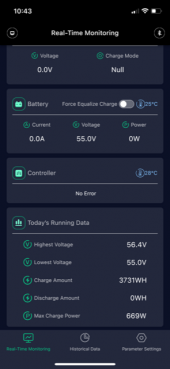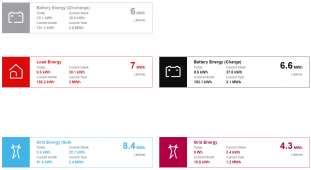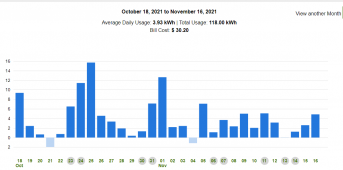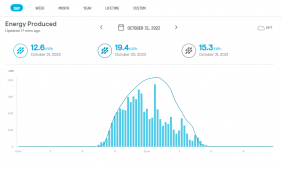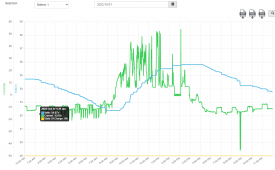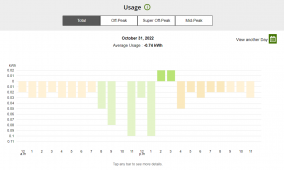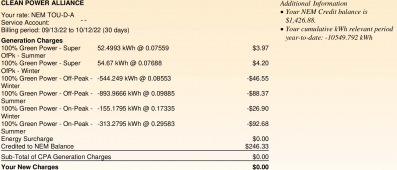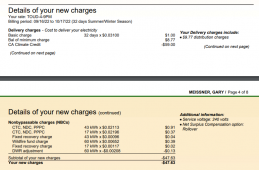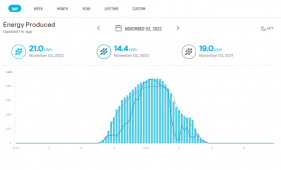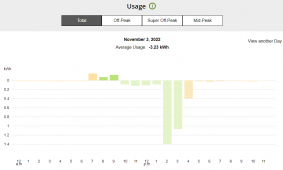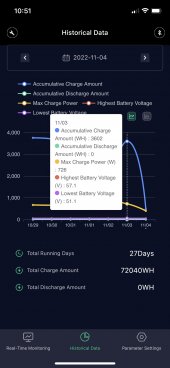My system hit a new milestone today. The NewPowa panels an Bouge RV charge controller exceeded 4,000 watt hours. It was fairly cool today, so the panels performed better, and there were virtually no clouds as well. I started typing this at 5:50 pm, and both the SilFab / Enphase and the NewPowa / Bouge RV systems are still making a little bit of power, but the fun part is, the 4,800 watts going into the Enphase system is making virtually the same power as the 1,000 watts going into the Bouge. Both are showing 20 watts. The sun is very low in the sky, there is a huge shadow across half of the SilFab panels, and all production will be done very soon. And sure enough, at 5:54 the Enphase system reported zero power. The Bouge is down to 13 watts. I have to wait abut 6 more minutes for Enphase Enlighten to update for the total watt hours today. The Bouge is still counting up, but it is basically done at 4,019 watt hours with only 0.27 amps still going into the battery system. Since the Enphase is no longer helping, the XW-Pro is pulling 11 amps out of the batteries, so the small current from the DC panels is just barely slowing the discharge now.
Here are a couple interesting pictures.

It's a little hard to see in this picture, but when I took that at 4:36 pm, the front row of panels is casting a shadow onto the very bottom row of cells of the back row. So I think from even before this, I was pretty much down to just the front row doing all of the work.
I have not changed the settings in the XW-Pro yet. It is still set to charge to 56.98 volts. With the help of the DC charging, it hit 56.9 volts by just 12:37 pm. At that point, I cap the max charge rate to 25% from the XW. But with the 25% still, and 12 amps coming from the DC charging, it only took 11 minutes to get to the 56.98 volt Bulk Charge limit, so the XW fell down to absorb, and the Enphase power started exporting over 2,000 watts. Absorb only lasted 6 minutes until it saw the voltage was holding with the current down to zero. Here is the graph as of 6:13 pm
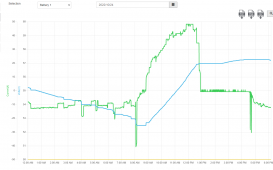
But this graph also shows something else. At 2:35 pm, more than 1.5 hours after the XW stopped it's charging, the battery voltage, being reported by the XW stats to show the voltage climbing. The DC panels are really doing their job here. Since the old solar panels are still fully powering the house, the battery bank is under essentially no load and even the small 8 to 10 amps coming in from the small DC array is enough to keep them charging higher. Now, I still don't want to push then too high, but this is not enough for concern. The original rating for these cells it 4.2 volts per cell which would be 58.8 volts for the 14S battery bank. I se the Bouge charge controller to 57.6 volts to keep it from going back to BOOST mode. The highest voltage the XW reports for the battery is 57.25 volts, and the BMS showed it at 57.20 volts. The Bouge RV charge controller was showing 57.4 with a peak reading showing 57.5 volts. Each cell in my old battery bank, with the JK BMS was showing from 4.085 to 4.087 volts, yes just 0.002 volts from lowest to highest cell. And the BMS is reporting that as 92% charged.

That was back at 4:32 while the DC panels were still making a little power, charging at 1.2 amps into the old bank, a little more is going into the new bank as well. But that is the highest voltage reading I was able to capture. Shortly after 6 pm, the voltage starts dropping as the XW starts using battery power to run my house. Here is the 1,000 watt array again as the power fell to 10 watts, look how the shadows are barely visible under the panels, it is just the light scatter in the clouds making that little power.
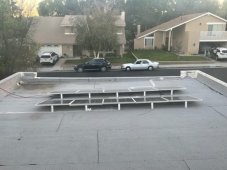
And as the Bouge controller finally shuts down, the total DC charge power fo the day ended at...
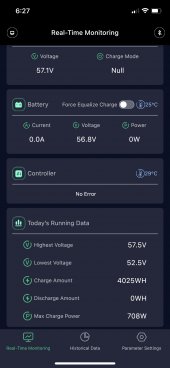
4,025 watt hours. Peak power hit 706 watts. 70.6% of array rating, and 4.025 Sun Hours of production.
Meanwhile, here is the final production for the Enphase panels today.
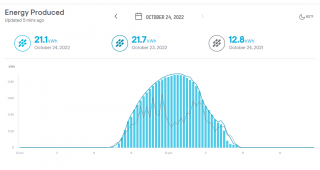
Peak power averaged for 15 minutes hit 3,500 watts or 72.9% of the panel rating, so still beats the DC setup there. And total energy for the day hit 21.1 KWH out of 4.8 KW of panels for 4.396 sun hours, again, still beating the DC system. It has been pretty consistent, the new DC setup is getting just 91.6% of the sun hours of the old panels. My guess is that both the NewPowa panels and the Bouge charge controller are only getting 96% of their ratings. That is within the "fudge factor" range on a spec sheet, within 5%. So the panels are really just 95 watts, and the 98% efficient charge controller is really just 92% efficient. They might be a tick better than that, and my angles and the shadows are holding it back a hair, but even if that is the best they can do, it is decent for the price to my door, with the free shipping etc. This is a lot better than you get with a lot of the cheaper Chinese made stuff out there. And it also goes to show that my higher tier SilFab Enphase equipment is holding up just fine after 3 years in the hot So Cal sun.
I am temped to take over one of the SilFab panels for a day and see how it performs on the Bouge charge controller. I just don't think I have enough cable to reach the old array, and I don't want to move the panels. If I also then connect 4 of the new panels to the Enphase inverter in series parallel, it should work fine, but by my math, it will clip the iQ7 inverter. The peak sun I got today, even saying they are 95 watt panel, the power of 4 could hit 277 watts. It won't hurt the inverter, but it should clip it at 240 watts for over an hour. But that might not tell me the peak power capability. I would get less power, but a more realistic measure if I series just 2 panels alone. Then the peak power will be around 139 watts. The maximum input voltage of the iQ7 is 48 volts, 2 of these panels will only total up to 45 volts. MPPT tracking range is 27 to 37 volts. I was seeing 80 to 90 volts for 5 panels in MPPT mode on the Bouge. That works out to 32 to 36 volts for a series pair. So it should gather every watt. This experiment could tell me if the panels are week, or the charge controller is not efficient.








